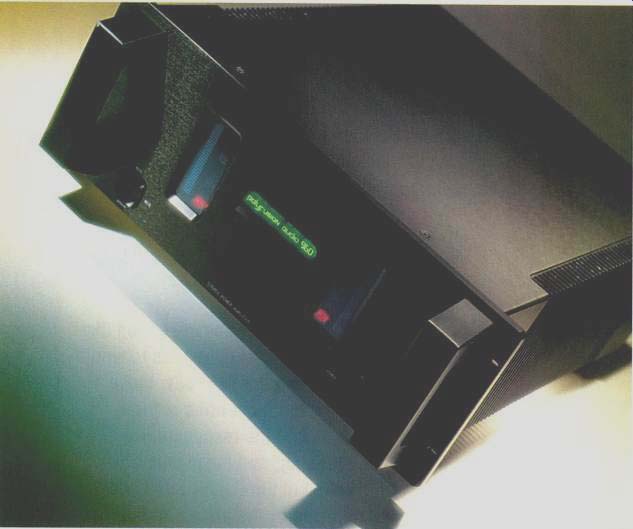
by BASCOM H. KING
Rated Power: 200 watts per channel into 8 ohms, 400 watts per channel into 4 ohms, or 600 watts per channel into 2 ohms.
Distortion: 0.02% THD at rated output.
Dimensions: 19 in. W x 8 in. H x 22 1/4 in. D (48.3 cm x 20.3 cm x 56.5 cm).
Weight: 70 lbs. (31.8 kg).
Price: $4,950.
Company Address: 30 Ward Rd., Lancaster, N.Y. 14086; 716/681-3040.
The Model 960 is Polyfusion Audio's top power amplifier (the company also makes two lower-power amplifiers and several preamplifiers and digital-to-analog converters). Rated at 200 watts per channel into 8-ohm loads, the Model 960 is a hefty 70-pound brute of an amp.
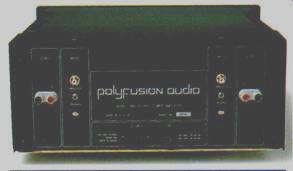
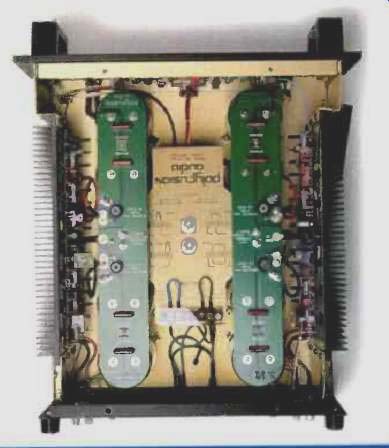
At the lower right of its attractive front panel is a rocker power switch, and opposite it, on the right side, is another rocker that switches the amplifier between automatic and manual muting. The panel's most prominent feature is a pair of illuminated, vertical display windows, one for each channel. In addition to bar-graph level meters, the windows contain indicators for clipping, overheating, DC fault, and muting. A switch on the bottom of the amplifier, near the right front, turns the level display on or off. The central logo window provides additional diagnostic information about the state of the positive-rail fuses. If the left-channel fuse blows, "Polyfusion" in the logo goes out; if the right-channel fuse opens, "Audio 960" goes dark.
The rear panel has rubber feet at the four corners, to prevent damage to protruding parts when the amp is set upright on its back. Two pairs of five-way binding posts for speaker connections (one pair per channel) are near the panel's edges. Between the output terminal pairs are the input connectors. These connectors are in two vertical arrays, each consisting of a high-quality phono jack for unbalanced input, a toggle switch for selecting unbalanced or balanced input, and an XLR connector for balanced input. An IEC AC cord socket and fuse are at the lower center.
Most of the 960's interior volume is taken up by its very capacious power supply. A large toroidal power transformer in the center is covered by a gold-anodized aluminum plate. This plate serves to mount a terminal strip with jumpers for accommodating different AC line voltages and as a heat sink for the two main bridge rectifiers.
Oriented in a line from front to back, on either side of the power transformer, are two banks of four 47,000-microfarad filter capacitors, totaling an impressive 376,000 microfarads! A printed circuit board links the individual capacitors in each bank and also carries the main supply-rail fuse holders, a 1-microfarad film bypass capacitor for each of the 47,000-microfarad electrolytics, and two yellow LEDs-with associated dropping resistors-to indicate when the capacitors are holding a (potentially dangerous) charge.
Each amplifier module consists of a p.c. board mounted to its associated heat sink. Brackets on the fronts and backs of the heat sinks extend to the front and rear panels, thus making up the length of each side. The output terminals are mounted to the rear brackets and extend through a hole in the back panel. By disconnecting two ribbon cables and three wires to the filter-capacitor bank p.c. boards, you can remove a module for service. Another p.c. board, mounted behind the front panel, holds all of the indicator circuitry. The Model 960 is nicely made, neatly wired, and appears to use appropriate high-quality parts.
========
CIRCUIT HIGHLIGHTS
Polyfusion Audio requested I sign a non-disclosure agreement to get a schematic of the Model 960. Accordingly, I can discuss the circuitry in only a general way. I will say that there are definitely some unusual things going on in this design.
The signal circuitry consists of seven main functional blocks. The unbalanced inputs are connected to one terminal of the input selector, which comprises the first block. The balanced inputs are applied to the input of a noninverting op-amp (a popular Burr-Brown device), configured as a unity-gain differential amplifier, which comprises the second block. The input selector's wiper, or out put, is routed to the input of another of these op-amps (the third circuit block), but connected for a gain of about four times. Following this input amplifier is the fourth block, a series electronic switch that is normally configured to pass the signal into the power amplifier proper, the fifth system block.
The power amplifier itself is a fully complementary design consisting of a J-FET differential first-stage amplifier, a bipolar transistor LVA (last voltage amplifier), and an output stage using six pairs of MOS-FET power devices. Over all negative feedback is applied from the output back to the input differential amplifier. Gain is set at five times (about 14 dB) and, in combination with the four-times gain of the input op-amp, sets the overall gain at 20 times, or 26 dB. A servo circuit that compares the DC level at the output to ground keeps output DC offset to a minimum.
Comprising the sixth function block is the Model 960's extensive protection circuitry. This starts at the fundamental level with the AC line fuse, a 15-ampere slow-blow type, and the power-supply rail fuses, which are 7-amp fast-blow types. An output relay connects the amplifier to the load after a short power-on delay. Any one of the following conditions will open this relay: turning the front-panel muting switch on, loss of AC power, excessive DC voltage at the out put, excessive power-supply current into the amplifier modules, too low a load impedance, or excessive temperature on the heat sinks.
Currents for the positive and negative power-supply inputs to each channel are sensed by separate circuits. If the current on either supply rail is excessive, the electronic switch that comprises block four will change state, disconnecting the power amplifier proper from the input signal. This happens almost on an instantaneous, per-cycle basis. When the current overload is just beyond the triggering threshold, individual signal cycles are re moved from the amplifier output; if the current overload becomes more severe, the output relay opens up. A last, but interesting, feature of the protection circuit is a load sensor. When the amplifier is muted for any reason, the sensor injects a measured DC current into the load. If the voltage it senses across the load with this current flowing is below a certain threshold, corresponding to a load impedance that it considers too low, the load sensor prevents the amplifier from un-muting.
The circuitry for the front-panel displays makes up the Model 960's seventh functional block, and the main power supply is the eighth.
-B.H.K.
========
Measurements
The Polyfusion 960's voltage gain was 26.1 dB in each channel and input mode, and the amplifier did not invert polarity.
My usual frequency response test at the 2.83-volt (1 watt into 8 ohms) output level with open-circuit, 8-ohm, and 4-ohm loading revealed little difference as a function of load. It was therefore no surprise that the NHT dummy speaker load hardly altered the response at all: less than 0.1 dB relative to 8-ohm loading over the 20 Hz to 20 kHz audio range. Response was up 2 dB at 10 Hz, however.
Out of curiosity, I used the Micro Cap IV program on my computer to model the amplifier as an equivalent op-amp along with the complete servo circuit. This model showed a different response, with a broad hump of 0.33 dB centered around 100 Hz and output at 10 Hz down almost 2 dB.
Hmmm. Then I checked the 960's frequency response as a function of output level and found that it changed. Figure 1 illustrates this phenomenon. The response be low 200 Hz changes from one shape below 1 volt output to another shape above about 1.7 volts. The top curve in the figure is what my original measured curves looked like, whereas the bottom curve is similar to the response my computer model predicted.
Apparently, the servo is designed to act in some nonlinear fashion that Polyfusion considers sonically beneficial (see "Circuit Highlights").
Square-wave response is shown in Fig. 2. The top and middle traces-for a 10-kHz waveform at 10 volts, peak to peak, with 8-ohm loading and then 8 ohms in parallel with 2 microfarads-are typical of most solid-state amplifiers. In the bottom trace, for a 40-Hz square wave, you can see the effects of the level-variant response.
Two waveforms are superimposed: The one with more tilt is scaled at 1 volt/division, whereas the one with the flatter but rounded top is a 10-volt peak-to-peak signal scaled at 5 volts/division. High-frequency rise and fall times were about 3.2 microseconds at 10 volts, peak to peak, into 8 ohms.
Common-mode rejection ratio (CMRR) for the balanced inputs was similar in the two channels.
From 20 Hz to 2 kHz, it was 66 dB for the left channel and 74 dB for the right. CMRR decreased to 61 and 68 dB at 20 kHz for left and right channels, respectively.
Figure 3 shows total harmonic distortion plus noise (THD + N) and SMPTE intermodulation (IM) distortion as functions of output power at 1 kHz into 8- and 4-ohm loads. The 4-ohm curves don't continue into clipping because the amplifier's protection circuitry started cutting in just beyond 400 watts output.
THD + N as a function of frequency, taken at several power levels, is plotted in Fig. 4. The rise in distortion below about 500 Hz is most likely due to whatever characteristic of the servo circuit causes the change in frequency response with level. A spectrum of the harmonic-distortion residue of a 1-kHz, 10-watt signal into 8 ohms is plotted in Fig. 5. Both even and odd harmonics are present but quickly recede into the noise floor.
The Polyfusion 960's interchannel crosstalk performance was out standing. In either direction, right to left or left to right, and with balanced or unbalanced input connections, channel separation was better than 110 dB from 20 Hz to 20 kHz.
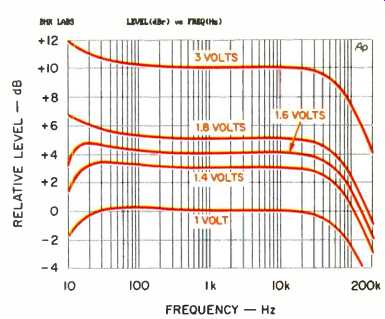
Fig. 1--Frequency response into 8 ohms at various output levels.
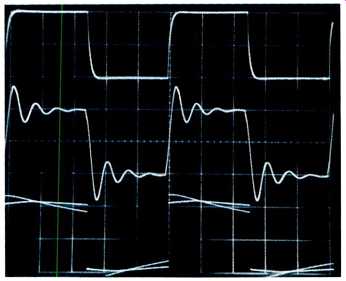
Fig. 2-Square wave response for 10 kHz into 8 ohms (top), 10 kHz into 8 ohms
paralleled by 2 pF (middle), and 40 Hz. into 8 ohms (bottom). The overlaid
40-Hz traces represent response at two different output levels, with the one
showing the flatter top scaled at the same 5 volts per vertical division as
the 10-kHz traces and the other scaled at 1 volt per division (see text).

Fig. 3-Distortion vs. power, THD + N at 1 kHz and SMPTE IM.
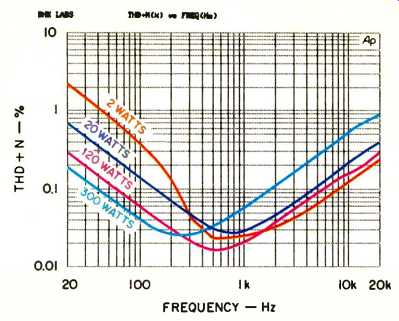
Fig. 4-THD + N vs. frequency into 4 ohms.
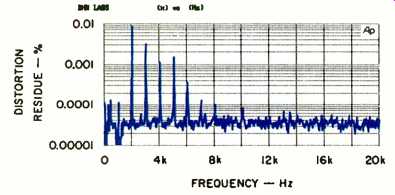
Fig. 5-Harmonic-distortion spectrum for 1-kHz signal at 10 watts into 8 ohms.
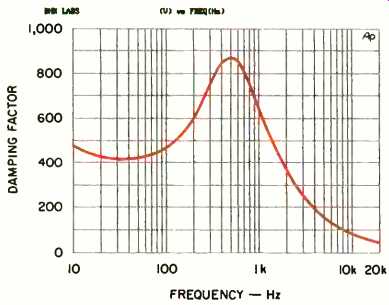
Fig. 6-Damping factor vs. frequency into 8 ohms.
The 960's A-weighted noise ranged from about -91 to -93.7 dBW for the two channels, whether in balanced or unbalanced mode.
The absolute level of the output noise between 22 Hz and 22 kHz ranged from 81 to 116 microvolts.
Damping factor versus frequency is shown in Fig. 6. The curve's shape is rather unusual. Damping factor is very high (which is to say, output impedance is very low) at around 500 Hz, reaching almost 900, and, as is typical, falls off at higher frequencies, to about 100 at 8 kHz and 50 at 20 kHz. What's odd is the depression in the curve below 500 Hz, though it never dips below 400 in that range. It most likely is caused by the action of the output-centering servo getting into the act in the lower part of the audio range and thereby increasing the output impedance.
The Polyfusion 960's output DC offset measured -0.5 millivolts in the left channel and -3.7 millivolts in the right. Input impedance was 524 ohms in balanced input mode and 26.4 kilohms in unbalanced input mode.
With the IHF tone burst, dynamic power into 8 ohms was 280 watts, with no sag over the course of the 20-millisecond burst, yielding a dynamic headroom of 1.5 dB relative to rated continuous out put. With 4-ohm loads, the dynamic current limiter started to engage before the amp actually voltage clipped. I was able to get 421 watts before limiting set in, for a dynamic headroom of 0.21 dB. With 2-ohm loads, I could get about 360 watts before the current limiters cut in. The limiting manifested it self in the tone-burst output as an absence of complete cycles of the signal, along with sharp discontinuities in cycles where the limiter cut in. Steady-state outputs at the visual onset of clipping or current limiting were 250, 400, and 350 watts for 8-, 4-, and 2-ohm loads, respectively.
The AC line current drawn by the 960 was about 2.4 amperes when it was quite cold and 2.1 amps when it was fully warmed up.
I measured the voltage drop across the various source resistors in the output stage and deduced an out put-stage idling current of some 450 milliamps, or a power dissipation of some 65 watts per channel--a healthy amount, to be sure, but more or less normal for MOS-FET output stages.
Use and Listening Tests
=========
ASSOCIATED EQUIPMENT USED
Equipment used in the listening tests for this review consisted of:
CD Transports: Sonic Frontiers SFT-1, conrad-johnson DR1, and Counterpoint DA-11A
CD Electronics: Genesis Technologies Digital Lens anti-jitter device; Classé Audio DAC-1 and Sonic Frontiers SFD-2 Mk II D/A converters
Phono Equipment: Oracle turntable, Well Tempered Arm, Accuphase AC-2 moving-coil cartridge, and Vendetta Research SCP-2C phono preamp
Additional Signal Sources: Nakamichi ST-7 FM tuner, Nakamichi 250 cassette deck, and Technics 1500 open-reel tape deck Preamplifiers: Forssell balanced tube line driver, Anthem Pre 1, and my own passive signal selector/volume control unit.
Other Power Amplifiers: Sonic Frontiers Power-3 mono tube amplifiers, Quicksilver M135 mono tube amplifiers, and Crown Macro Reference.
Loudspeakers: B&W 801 Matrix Series 3s, augmented from 20 to 50 Hz by two subwoofers, and Genesis Technologies Genesis Vs.
Cables: Digital interconnects, AES/EBU balanced Illuminati DX-50; analog interconnects, Transparent Cable MusicLink Reference (balanced) and Music and Sound (unbalanced); speaker cables, Transparent Cable MusicWave Reference.
Other: TAD Systems Power Purifier on AC lines to all D/A converters and preamps
=========
I first listened to the Polyfusion 960 on a pair of Genesis V speakers. I had a bit of a surprise at first; when the turn-on delay ended and the amplifier came out of muting, I heard a loud pop through the speakers. This led me to believe something was speaker as the crossover capacitors discharge the 18 volts back through the now-active amplifier. The cure for this annoyance was to start the amp up with 4- to 8-ohm resistors temporarily bridged across the speaker terminals and then to take them off after the amp un-muted. I dwell on this a bit because there are other full-range speakers from Infinity, Genesis, and possibly others with series capacitors in their crossovers that will react similarly with the Model 960.
My initial reactions to the 960's sound were somewhat mixed. They ranged from thinking the amp sounded dark and closed in to thinking it sounded reasonably good.
After a number of separate listening sessions, interspersed with lab measurements (and perhaps because it became more bro ken in over this period), the 960 ended up sounding quite good on the Genesis speakers. Its sound was characterized by a smooth, somewhat laid-back perspective, with little irritation yet good resolution and detail. Space, dimension, and soundstaging were very good. The blend of this amp's sound in the lower midrange to the Genesis V's powered woofer system was good.
With B&W 801 Matrix Series 3 speakers, I thought the same things about the sound of the 960 as with the Genesis Vs. However, the amp was now also handling the bass and good, robust, powerful bass it was.
Tight and tuneful, it was as good as I've heard with the 801s. The overall sound of the 960 on the 801s was relaxed, realistic, musical, and enjoyable.
Playing the low-sensitivity B&W 801s, I was easily able to clip the amp on wide dynamic range drum solos, but the 960 handled this gracefully and thus did not sound unduly bad. With the Genesis Vs, which are a lower-impedance load but don't load the amp in the bass range, the 960 played louder than I could stand, without limiting in any audible way.
The Polyfusion Audio 960 amplifier was a pleasure to listen to. I would commend it to anyone seeking a high-performance, high-power solid-state amplifier.
This article adapted from Audio magazine, March 1997.
Also see: Parasound HCA-2200-II Amplifier (Equipment Profile, Aug. 1993)
============